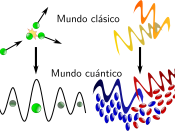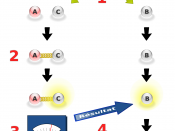Unification Theory In particle physics, an attempt to explain all of the fundamental forces and their relationships between elementary particles in single framework was accomplished in theory by the g.u.t. by the grand unification theory. In relation to physics these forces can be described as fields that mediate interactions between separate or distant objects. These theories such as eltromagnetism and general relativity started to attempt the unification of theories, however they would emerge as the fundamental basics of the g.u.t. Or the grand unification theory. At sub atomic levels, these fields are described as quantum field theories, which started the ideas of quantum mechanics. In the 1940's the ideas quantum electrodynamics (QED), the quantum field theory of electromagnetism, became fully developed. In QED, charged particles interact as they emit and absorb photons (minute packets of electromagnetic radiation), in effect exchanging the photons in a game of subatomic catch. This theory has become the prototype for theories of the other forces.
During the 1960s and '70s particle physicists discovered that matter is composed of two types of basic building block--the fundamental particles known as quarks and leptons. The quarks are always bound together within larger observable particles, such as protons and neutrons. They are bound by the short-range strong force, which overwhelms electromagnetism at sub nuclear distances. The leptons, which include the electron, do not feel the strong force. However, quarks and leptons both experience a second nuclear force, the weak force. This force, which is responsible for certain types of radioactivity classed together as beta decay, is feeble in comparison with electromagnetism. At the same time that the picture of quarks and leptons began to crystallize, major advances led to the possibility of developing a unified theory. Theorists began to invoke the concept of local gauge invariance, which postulates...

